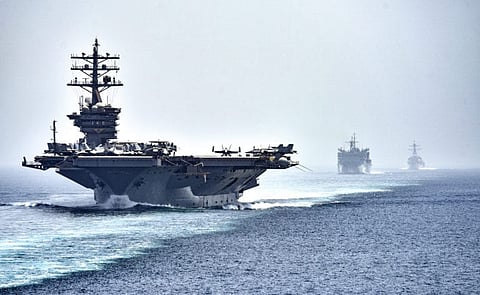Strait of Hormuz, World’s most important fairway
Iran threatened to close the Strait of Hormuz if it is prevented from using the strategic waterway, which accounts for passing about a fifth of the oil consumed worldwide.
The threat posed by an Iranian Revolutionary Guard official came after the United States announced on Monday that it would end the exemptions it granted last year to eight Iranian oil buyers, requiring importers to stop purchases by May 1st, otherwise, they will face sanctions.

The Strait of Hormuz, one of the world's oldest marine lanes, links oil producers in the Middle East to the markets of Asia, Europe, North America, and beyond. Being the only maritime port of the Gulf States located on the Arabian Sea and the Arabian Gulf, it has been at the heart of regional tension for decades.
Iran has previously threatened to close the Strait of Hormuz without enforcing such threats.
What is the Strait of Hormuz?
This waterway separates between Iran and Oman and connects the Gulf of Oman and the Arabian Sea. Strait of Hormuz's widths is 33 km in its smallest part, but the fairway's width is not more than three kilometers in both directions.
Why is it important?
TheUS Energy Information Administration (EIA) estimated that 18.5 millionbarrels of sea-transported oil per day crossed the strait in 2016. Thataccounted for about 30 percent of the crude and other oil liquids shipped bysea in 2016.
Anestimated 17.2 mb/d of crude and condensates have been transported across thestrait in 2017, and 17.4 mb/d in the first half of 2018, Forticsa company foroil analyses said.
With the global consumption of oil reaches around 100 mb/d, it means that about one-fifth of that amount passes through the Strait of Hormuz.
Most of the crude exports of Saudi Arabia, Iran, the United Arab Emirates, Kuwait, and Iraq, all of which are members of the OPEC, pass through the Strait of Hormuz.
Almost all the LNG production of Qatar, the world's largest LNG exporter, also passes through the Strait of Hormuz.
Between1980 and 1988, both Iraq and Iran sought to block the oil exports of the othercountry in what was then known as the Tanker War.
TheUS Fifth Fleet based in Bahrain is charged with protecting merchant ships inthe region.
"Althoughthe presence of the US Fifth Fleet is supposed to ensure that the vitalwaterway remains open, it is likely that Iran will conduct provocative militarymaneuvers in the near future and resume its nuclear activities," an analyst atRBC Bank said on April 22.
Iranhas agreed to curb its nuclear program in exchange for easing sanctions under a2015 deal with the United States and five other world powers. Washington haspulled out of the deal in 2018. The Western powers fear Iran wants to buildnuclear weapons, a charge Tehran denies.
"Allthese geopolitical factors may suggest that a harsh summer awaits PresidentDonald Trump as he tries to keep oil prices under control," RBC analysts said.
Are there alternative routes to Gulf oil?
The United Arab Emirates and Saudi Arabia are seeking other ways to avoid passage through the Strait of Hormuz, including the extension of more oil pipelines.
Thefollowing are IEA data showing existing pipelines and proposed projects:
- Working pipelines that do not cross the Strait of Hormuz (2016):
- Petro-line (East-West Pipeline): a working Saudi line with a capacity of 4.8 mb/d, of which 1.9 mb are already used, while its unexploited capacity is 2.9 mb/d.
- Abu-Dhabi Crude Oil Pipeline: A 1.5 mb/d Emirati line, of which half a million barrels are used, while unexploited energy is one million barrels.
- Abqaiq-Yanbu natural gas liquids line: A Saudi line with a capacity of 300,000 bd, fully exploited.
- Iraqi pipeline in Saudi Arabia: Saudi pipeline turned to pump natural gas.
*The total capacity of all these lines is 6.6 mb/d, of which 2.7 mb are used,while the unused capacity reaches 3.9 mb.
Anterior incidents the Strait of Hormuz witnessed:
– InJuly 1988, the American warship Vincennes dropped an Iranian aircraft, killing290 people on board, while Washington said it was an accident in which the crewthought the aircraft was a fighter jet. The United States said Vincennes was inthe area to protect neutral ships from Iranian naval strikes.
– Early in 2008, the United States said Iranian boats threatened its warships after approaching three US naval vessels in the Strait of Hormuz.
– In June 2008, Iran's Revolutionary Guards commander, Mohammad Ali Jafari, said that Iran would impose restrictions on passage through the strait of Hormuz if attacked.
– InJuly 2010, Japan's M-Star oil tanker was attacked in the strait of Hormuz. Amilitant group known as the Abdullah Azzam Brigades, which are linked to Al-Qaeda,claimed responsibility for the attack.
– In January 2012, Iran threatened to close the Strait of Hormuz in response to US and European sanctions targeted its oil revenues in an attempt to stop Tehran's nuclear program.
– InMay 2015, Iranian vessels fired shots at a Singapore-flagged tanker that Tehransaid had destroyed an Iranian oil platform, prompting the carrier to flee. Italso confiscated a container ship in the strait of Hormuz.
– In July 2018, Iranian President Hassan Rowhani hinted that his country could disrupt oil transit through the Strait of Hormuz in response to US calls to cut Iran's crude exports to zero. A Revolutionary Guards commander also said Iran would stop all exports across the strait if Iranian exports were stopped.


